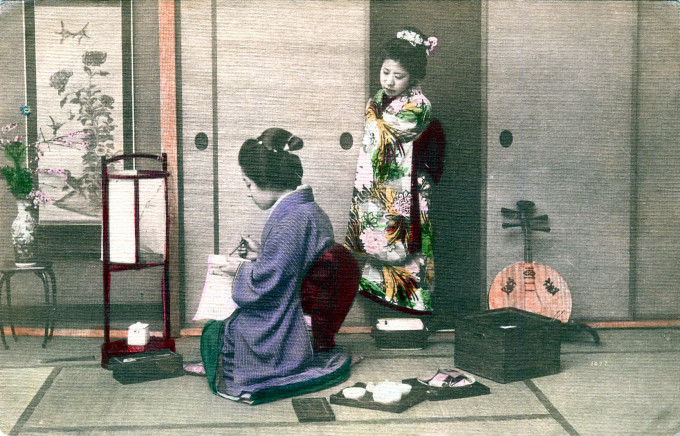“The gekkin is a Chinese instrument (yue qin, in pinyin, or ‘moon lute’) much used in Japan. It consists of a circular, double, flat, imperforate sounding board about fourteen inches in diameter and an inch and half in thickness. Inside the sounding board a piece of metal wire is loosely attached which jingles when the instrument is played upon. The handle is about ten inches long. In the head of it are inserted four winding pegs which serves to tighten two double strings in mandolin style only the strings are not made of wire but of hemp.
“The music for the gekkin consists almost entirely of quaint little Chinese songs, many of them very melodious and pretty. It is played with a small ivory or tortoise-shell plectrum, the double strings giving a trill to the notes which are accentuated by the vibrations of the loosely attached wire inside the body … The up and down stroke of the plectrum, which is characteristic of Chinese and Japanese music, acquires additional grace by coming on different strings.
“There are in Japan two distinct schools of gekkin players, and their instruments differ appreciably. Mr. Nagahara, a brilliant performer on the Chinese violin, is president of an orchestra known as the Nagahara Society, in whose concerts the gekkin is an important instrument. The other school, which is more modern, was established by Nippon Keian, a celebrated player of forty years ago. Then besides these two schools of high class gekkin players, there are innumerable lower class orders of players, whose instruments cannot of course be expected to be so good. In the eyes of the Japanese, Chinese made instruments are regarded as being much superior to the home-made article.
“Plucked instruments are historically associated with storytelling, epic singing, and drama. According to the traditional history, the earliest version of this instrument, the ruan, was invented in the third century, and arrived in Japan via Formosa and Okinawa.”
– The Gekkin Music Scale, by F. Du Bois, M.D. (from Transactions of the Asiatic Society of Japan), Jan. 14, 1891
Onnanoko with gekkin (instrument), c. 1910.
1910s • Arts & Culture • Geisha/Maiko/Onnanoko
Tagged with: Geisha/Maiko, Gekkin, Music, Stringed instruments, Yeu qin
Please support this site. Consider clicking an ad from time to time. Thank you!


